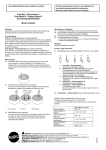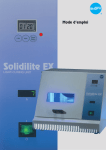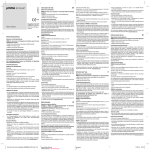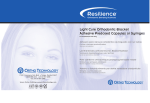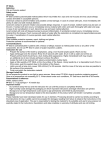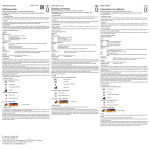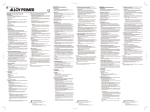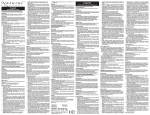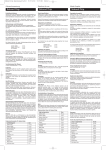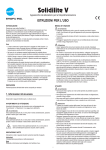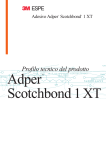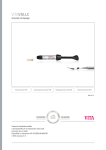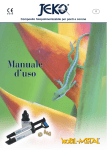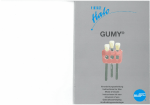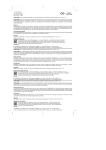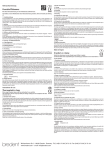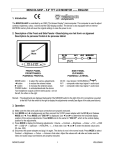Download BPZ Cerasin Bond 6Sp/A4/Q
Transcript
CERARESIN BOND Gebrauchsanweisung – Deutsch Instructions for Use – English Mode d'emploi – Français Verbundlösung für Komposit und Keramik Bonding Agent for Porcelain and Composite Collage sur céramique et composite CERARESIN BOND ist ein lichthärtendes Verbundsystem, welches Komposit bei Neuanfertigungen oder Reparaturen mit K&B Kompositen, Prothesenbasis- oder Füllungsmaterialien, die Keramik oder Komposit enthalten, verbindet. Das Produkt kann sowohl intraoral als auch extraoral angewendet werden. Applikationsbereiche: – Anwendung als Adhäsiv bei der Reparatur von keramischen Restaurationen mit Füllungsmaterialien, K&B Kompositen oder Prothesenbasismaterialien. – Anwendung als Adhäsiv bei der Modifizierung und Reparatur von Porzellan- oder Kunststoffzähnen mit Füllungsmaterialien, K&B Komposit oder Prothesenbasismaterialien. – Anwendung als Adhäsiv bei der Herstellung von Restaurationen, die Füllungsmaterialien, K&B Komposit oder Prothesenbasismaterialien enthalten, oder der Reparatur mit Füllungsmaterialien, K&B Kompositen oder Prothesenbasismaterialien. – Anwendung als Adhäsiv bei der Reparatur mit Füllungsmaterialien von Restaurationen aus Dentalkeramiken, K&B Kompositen, Füllungsmaterialien oder Prothesenbasismaterialien. Verarbeitungsanleitung: Die Polymerisationszeiten beziehen sich auf das SHOFU Griplight II und das SOLIDILITE EX Polymerisationsgerät. Sollten Sie ein anderes Lichtpolymerisationsgerät verwenden, so verfahren Sie bitte nach der Gebrauchsanleitung des Geräteherstellers. Lichthärtegerät SHOFU Solidilite-EX SHOFU Griplight II Polymerisationszeit 3 Min. 20 Sek. 1. Vorbereitung der Verbundfläche – Für die intraorale Anwendung Die Verbundfläche mit rotierenden Instrumenten (z. B. Diamond Point, etc.) anrauen, anschließend mit Wasser reinigen und trocknen. Falls erforderlich, die Verbundfläche mit Phosphorsäure anätzen, anschließend mit Wasser reinigen und trocknen. – Für die extraorale Anwendung Die Verbundfläche mit rotierenden Instrumenten (z. B. Diamond Point, etc.) anrauen oder mit 50 – 100 µm Aluminiumoxyd abstrahlen. Anschließend mit Wasser reinigen und trocknen. Falls erforderlich, die Verbundfläche mit Phosphorsäure anätzen, anschließend mit Wasser reinigen und trocknen. 2. Auftrag und Ablüften Bond I Eine dünne Schicht Bond I auf die gesamte Verbundfläche mit einem Pinsel auftragen, anschließend 10 Sekunden ruhen lassen. 3. Auftrag und Ablüften Bond II Eine dünne Schicht Bond II auf die gesamte Verbundfläche mit einem Pinsel auftragen, anschließend 10 Sekunden ruhen lassen. 4. Aktivieren Die Oberflächenlichthärtung der Verbundschichten erfolgt mit einer Stabpolymerisationslampe oder einem Lichthärtegerät. 5. Auftrag des Komposites Folgen Sie bei der Anfertigung oder Reparatur den Angaben des Materialherstellers. Sicherheitshinweise: 1. Das Produkt darf nicht bei Patienten oder von Behandlern mit bekannter Kunststoff-Allergie verwendet werden. 2. Treten beim Patienten oder Behandler allergische Reaktionen, wie z. B. Hautausschlag oder Hautentzündungen durch dieses Produkt auf, Verwendung sofort einstellen und Arzt konsultieren. 3. Berührung von Weichgewebe, Haut oder Augen vermeiden. Bei versehentlichem Kontakt den betroffenen Bereich sofort mit Wasser gründlich spülen und, falls erforderlich, Arzt aufsuchen. 4. Bitte tragen Sie bei der Lichtpolymerisation eine UV-Schutzbrille. 5. Das Produkt nur für die angegebenen Applikationsbereiche verwenden. Das Produkt ist nur für den dentalen Gebrauch bestimmt. 6. Das Produkt ist acetonhaltig. In gut belüfteten Räumen verwenden. Bei Einatmen von acetonhaltigem Dampf sowie bei Unwohlsein und Schwindelgefühl an die frische Luft gehen. Zusammensetzung: Bond I Liquid: Ethanol, Silan, etc. Bond II Liquid: Aceton, 4-AET, UDMA, Photoinitiatoren, etc. Warnhinweise: CERARESIN BOND (acetonhaltig) R11 Leicht entzündlich S7 Behälter dicht geschlossen halten S9 Behälter an einem gut belüfteten Ort aufbewahren S16 Von Zündquellen fernhalten – Nicht rauchen S23 Dampf nicht einatmen S33 Maßnahmen gegen elektrostatische Aufladungen treffen Lagerung: Von offener Flamme, Zündquellen oder direkter Sonneneinstrahlung fern halten und bei Raumtemperatur (1 – 30 °C / 34 – 86 °F) aufbewahren. Besonderer Hinweis: Nicht mehr nach Ablauf des Verfalldatums verwenden. CERARESIN BOND is a light-curing bonding system for bonding composite material that is used for restoring and repairing dental restorations made of crown material, denture base material, or dental filling material consisting ceramic or composite. The product is used intra- or extra orally. CERARESIN BOND est un système photo polymérisable destiné au collage des composites utilisés pour les restaurations et les réparations dentaires, couronnes, résine de base, ou obturations en céramique ou composite. Il s'utilise en dehors ou en bouche. Indications: – Used as adhesive when ceramic restorations are to be repaired with filling composite, C&B composite, or denture base material. – Used as adhesive when porcelain or resin teeth are to be modified and repaired with filling composite, C&B composite, or denture base material. – Used as adhesive when dental restorations consisting C&B composite, filling composite, or denture base material, are to be fabricated or repaired with filling composite, denture base material, or C&B composite. – Used as adhesive when dental restorations made of dental ceramic, C&B composite, filling composite, or denture base material, are to be repaired with and filling material. Indications: – Utilisé comme adhésif lorsque des restaurations céramiques doivent être élaborées ou réparées avec un composite d'obturation, un composite C&B, ou une résine de base. – Utilisé comme adhésif pour la fabrication des dents en porcelaine ou résine et la réparation avec un composite d'obturation, un composite C&B, ou une résine de base. – Utilisé comme adhésif quand des restaurations en composite C&B, composite d'obturation ou résine de base doivent être élaborées ou réparées avec ces mêmes types de matériaux. – Utilisé comme adhésif lorsque des restaurations en céramique, composite C&B, composite d'obturation, ou résine de base doivent être réparés avec un adhésif et un produit d'obturation. Instructions: The following table shows the typical light-curing times when the dental light-curing units SHOFU Griplight II or SOLIDILITE-EX are used. When other dental visible light-curing units are used, please refer to their instruction manual to obtain appropriate amount of light for this product. Light-curing unit SHOFU Solidilite-EX SHOFU Griplight II Time of exposure 3 min. 20 sec. 1. Adherent surface treatment (pre-treatment) – For intraoral application Roughen the adherent surface with abrasives (Diamond Point, etc.). Rinse with water and dry. Then treat the surface with phosphoric acid-base etching agent if necessary. Rinse with water and dry. – For extraoral application Roughen the adherent surface with dental abrasives (Diamond Point, etc.), or sandblast with 50 – 100 µm alumina particles. Rinse with water and dry. Then treat the surface with phosphoric acid-base etching agent if necessary. Rinse with water and dry. 2. Application and drying of Bond I Apply one coat of Bond I onto the whole adherent surface using a brush. Leave it undisturbed for 10 seconds. 3. Application and drying of Bond II Apply one coat of Bond II onto the whole adherent surface using a brush. Leave it undisturbed for 10 seconds. 4. Light-curing (irradiation) Light-cure the surface with dental visible light or laboratory light-curing unit to polymerize the bonding layers. 5. Placement of composite material Perform restoration or repair work using composite material according to manufacturer’s instruction manual. Safety Recommendations: 1. Avoid using this material with patients known to suffer from acrylate resins allergies. (This pertains also to the operator.) 2. If allergic reactions occur such as eruption or skin inflammation while using this product, immediately discontinue the use and have the patient seek medical advice. (The same precaution is applied for the operators.) 3. Avoid contacting mucosa, skin or eyes. In case of contact, rinse immediately with copious amounts of water and seek medical advice, if necessary. 4. Wear UV protective glasses when light curing. 5. Do not use this product for any other purpose except for the purpose mentioned in the indication. This product is intended for dental use only. 6. This product contains ethanol and acetone. Use it in a well-ventilated room. In case of inhaling ethanol and/or acetone-containing vapor and feeling unwell or nauseous, rest in a place with fresh air. Composition: Bond I liquid: ethanol, silane coupling agent, etc. Bond II liquid: acetone, 4-AET, UDMA, light-curing catalyst, etc. Hazard Warnings: CERARESIN BOND (contains acetone) R11 Highly flammable S7 Keep container tightly closed S9 Store container in a well ventilated place S16 No naked flames – no smoking S23 Do not inhale vapor S33 Take precautions against electrostatic discharges Storage: Keep away from open flames or excess heat and store at room temperature (1 – 30 °C / 34 – 86 °F). Note: Do not use after expiry date. Applications: Le tableau ci-dessous indique les temps de photo polymérisation avec les appareils SHOFU Griplight II ou SHOFU SOLIDILITE-EX. Pour d'autres appareils consulter le manuel du fabricant pour connaître les temps d'insolation. Photo polymériseur Enceinte SHOFU Solidilite-EX Lampe SHOFU Griplight II Temps d'exposition 3 min. 20 sec. 1. Traitement de la surface de collage (prétraitement) – Utilisation en bouche Dépolir la surface pour obtenir une certaine rugosité (Pointe diamant, etc.). Rincer à l'eau et sécher. Si nécessaire, procéder à un mordançage à l'acide phosphorique. Rincer à l'eau et sécher. – Utilisation externe Dépolir la surface pour obtenir une certaine rugosité (Pointe diamant, etc.) ou sabler à l'alumine entre 50 et 100 µm. Rincer à l'eau et sécher. Si nécessaire, procéder à un mordançage à l'acide phosphorique. Rincer à l'eau et sécher. 2. Application de Bond I Appliquer une couche de Bond I sur toute la surface adhésive avec un pinceau. Laisser sécher 10 secondes. 3. Application de Bond II Appliquer une couche de Bond II sur toute la surface adhésive avec un pinceau. Laisser sécher 10 secondes. 4. Photo polymérisation Polymériser avec une lampe à photo polymériser de cabinet dentaire travaillant en lumière visible ou dans une enceinte de laboratoire. 5. Mise en place du matériau composite Pour la restauration ou la réparation, utiliser le matériau conformément au manuel d'instructions de celui-ci. Précautions: 1. Éviter d'utiliser ce matériau sur des patients allergiques aux résines acryliques. (Cela s'applique aussi à l'opérateur.) 2. En cas de réaction allergique comme par exemple, éruption ou inflammation cutanée, durant l'utilisation de ce produit, stopper l'opération et consulter un médecin. 3. Éviter tout contact avec les muqueuses, la peau ou les yeux. En cas de contact, rincer immédiatement avec de grandes quantités d'eau et consulter un médecin si nécessaire. 4. Porter des lunettes anti-UV durant la photo polymérisation. 5. Utiliser ce produit exclusivement aux fins indiquées. Ce produit est destiné exclusivement à une utilisation dentaire. 6. Ce produit contient de l'éthanol et de l'acétone. Il faut l'utiliser dans une pièce bien ventilée. En cas d'inhalation de vapeurs contenant de l'éthanol et/ou de l'acétone, si un malaise ou des nausées apparaissent, sortir à l'air libre. Composition: Bond I liquide: Éthanol, agent de liaison silane, etc. Bond II liquide: Acétone, 4-AET, UDMA, catalyseur photo, etc. Avertissement sur les risques d’utilisation: CERARESIN BOND (contient de l’acetone) R11 Hautement inflammable S7 Gardez l’emballage hermétiquement fermé S9 Stockez l’emballage dans un lieu ventilé S16 Pas de flammes nues – ne fumez pas S23 N’inhalez pas les vapeurs S33 Prenez des précautions contre les déscharges électrostatiques Conservation: Tenir à distance de flamme ou de source de chaleur excessive et conserver à température ambiante (1–30 °C / 34–86 °F). Remarque: Ne pas utiliser après la date d’expiration. CERARESIN BOND Gebruiksaanwijzingen – Nederlands Hechtmiddel voor porselein en composiet Instrucciones de uso – Español Istruzioni per l'uso – Italiano Adhesivo para porcelana y composite Agente adesivo per ceramica e materiali compositi CERARESIN BOND es un sistema adhesivo de fotopolimerización para la unión de material composite usado para restaurar y reparar restauraciones dentales realizadas con material para coronas, material de rebase o material de relleno dental formado a base de cerámica o composite. El producto es indicado para uso intraoral y extraoral. Indicación: – Usado como adhesivo en la fabricación o reparación de restauraciones cerámicas con composite de relleno, composite para coronas y puentes o material de rebase. – Usado como adhesivo en la fabricación o reparación de dientes de porcelana o resina con composite de relleno, composite para coronas y puentes o material de rebase. – Usado como adhesivo en la fabricación o reparación de restauraciones dentales compuestas por composite para coronas y puentes, composite de relleno o material de rebase, usando para ello composite de relleno, composite para coronas y puentes o material de rebase. – Usado como adhesivo en la reparación de restauraciones dentales compuestas por cerámica dental, composite para coronas y puentes, composite de relleno o material de rebase, usando para ello material de relleno y adhesivo dental. Aplicación: La siguiente tabla muestra los tiempos de fotopolimerización normales cuando se usan las unidades de fotopolimerización SHOFU Griplight II o SHOFU SOLIDILITE EX. Si se usan otras unidades de fotopolimerización con luz visible, le rogamos consulte su manual de instrucciones para determinar la cantidad de luz apropiada para este producto. Unidad de fotopolimerización SHOFU Solidilite EX SHOFU Griplight II CERARESIN BOND è un sistema adesivo fotopolimerizzabile, studiato per ripristinare o riparare protesi dentarie fisse, basi di protesi mobili o materiali dentali per ricostruzioni dirette in ceramica o composito utilizzando materiali compositi. Il prodotto è indicato per l’uso intra o extra orale. Indicazioni: – Quale adesivo nella realizzazione/riparazione di protesi in ceramica mediante composito per ponti e corone, composito per ricostruzioni dirette o materiale per basi protesiche mobili. – Quale adesivo nella realizzazione/riparazione di denti di ceramica o resina mediante composito per ponti e corone, composito per ricostruzioni dirette o materiale per basi protesiche mobili. – Quale adesivo nella realizzazione/riparazione con materiali per ricostruzioni dirette, compositi per ponti e corone o materiale per basi protesiche. Per manufatti in ceramica, in composito per ponti e corone, in materiale composito per ricostruzioni dirette o in materiale per basi protesiche mobili. – Quale adesivo nella riparazione con sistemi adesivi e materiali per ricostruzioni dirette. Per manufatti in ceramica, in composito per ponti e corone, in materiale composito per ricostruzioni dirette o in materiale per basi protesiche mobili. Applicazioni: La tabella seguente illustra i tempi di fotopolimerizzazione standard per i fotopolimerizzatori SHOFU Griplight II o SHOFU SOLIDILITE EX. Per altri apparecchi a luce visibile, consultare il manuale di istruzioni di riferimento per indicazioni su tempi e modi d’uso per questo prodotto. Fotopolimerizzatore SHOFU Solidilite-EX SHOFU Griplight II Tiempo de exposición 3 min. 20 seg. 1. Tratamiento de la superficie de adhesión (tratamiento previo) – Para aplicación intraoral Raspar la superficie de adhesión con abrasivos (Diamond Point, etc.). Limpiar con agua y secar. En caso necesario, tratar la superficie con una solución de grabado de ácido fosfórico. Limpiar con agua y secar. – Para aplicación extraoral Raspar la superficie de adhesión con abrasivos (Diamond Point, etc.) o aplicar chorro de arena con partículas de alúmina de 50 – 100 µm. Limpiar con agua y secar. En caso necesario, tratar la superficie con una solución de grabado de ácido fosfórico. Limpiar con agua y secar. 2. Aplicación y secado del Adhesivo I Usando un cepillo, aplicar una capa de Adhesivo I sobre toda la superficie de adhesión. Dejar secar durante 10 segundos. 3. Aplicación y secado del Adhesivo II Usando un cepillo, aplicar una capa de Adhesivo II sobre toda la superficie de adhesión. Dejar secar durante 10 segundos. 4. Fotopolimerización (irradiación) Fotopolimerizar la superficie con luz visible o una unidad de fotopolimerización de laboratorio para polimerizar las capas de adhesivo. 5. Colocación del composite Realizar el trabajo de restauración o reparación usando material composite de acuerdo con su manual de instrucciones. Precauciones: 1. Evitar el uso de este material con pacientes que sufren alergia a las resinas acrílicas. (Esto también afecta al operario.) 2. Si el uso de este producto provoca síntomas de hipersensibilidad, como erupciones o inflamaciones cutáneas, dejar de usar inmediatamente el producto y acudir a un médico. (Los operarios también deben adaptar la misma precaución.) 3. Evitar el contacto con tejidos blandos, piel y ojos. En caso de contacto, lavar inmediatamente con agua abundante y acudir a un médico, si fuese necesario. 4. Usar gafas de protección ultravioleta al fotopolimerizar. 5. No usar este producto para cualquier otro objetivo que el mencionado en la indicación. Este producto sólo es indicado para su uso dental. 6. Este producto contiene etanol y acetona. Usarlo en una habitación bien ventilada. Si se ha inhalado vapor que contenga etanol y/o acetona y se siente malestar o náuseas, descansar en un lugar al aire fresco. Composición: Líquido Adhesivo I: etanol, agente acoplante de silano, etc. Líquido Adhesivo II: acetona, 4-AET, UDMA, catalizador de fotopolimerización, etc. Advertencias de riesgos: CERARESIN BOND (contiene acetona) R11 Altamente inflamable S7 Mantener el envase bien cerrado S9 Almacenar el envase en un lugar bien ventilado S16 Mantener alejado de llamas abiertas – no fumar S23 No inhalar los vapores S33 Tomar precauciones contra las descargas electrostáticas Almacenamiento: Mantener alejado de cualquier fuente de ignición y almacenar a temperatura ambiente (1–30 °C / 34–86 °F ). Observación: No utilizar después de la fecha de caducidad. Tempo di Esposizione 3 min. 20 sec. 1. Trattamento della superficie d’adesione (pre-trattamento) – Applicazioni intra-orali Irruvidire la superficie di adesione con sostanze abrasive (Punta diamantata, ecc). Sciacquare ed asciugare. Se necessario, trattare la superficie con un agente mordenzante fosforico. Sciacquare ed asciugare. – Applicazioni extra-orali Irruvidire la superficie d’adesione con sostanze abrasive (Punta diamantata, ecc) o sabbiare con particelle di alluminio del diametro di 50 – 100 µm Sciacquare ed asciugare. Se necessario, trattare la superficie con un agente mordenzante fosforico. Sciacquare ed asciugare. 2. Applicazione ed essiccazione del Bond I Applicare uno strato di Bond I sull'intera superficie di adesione utilizzando un pennellino. Lasciare asciugare per 10 secondi. 3. Applicazione ed essiccazione del Bond II Applicare uno strato di Bond II sull'intera superficie di adesione utilizzando un pennellino. Lasciare asciugare per 10 secondi. 4. Fotopolimerizzare Trattare la superficie con una unità di luce visibile o una unità di trattamento con la luce da laboratorio per garantire la polimerizzazione degli strati diadesivo. 5. Introduzione del materiale composito Effettuare la ricostruzione o la riparazione utilizzando materiale composito secondo le istruzioni del manuale di riferimento. Avvertenze: 1. Non utilizzare questo materiale in pazienti con allergia manifesta alle resine acriliche. (Questo è valido anche per gli operatori) 2. Se si manifestano sintomi di reazioni allergiche, quali eruzioni o infiammazione cutanea, interrompere immediatamente l'uso del prodotto e contattare un medico. (Precauzione valida anche per gli operatori). 3. Evitare il contatto con le mucose, la cute o gli occhi. In caso di contatto, lavare immediatamente con grandi quantità di acqua e, se necessario, contattare un medico. 4. Durante il trattamento con la luce indossare occhiali di protezione per gli UV. 5. Non utilizzare il prodotto per scopi diversi da quelli specificati nelle indicazioni. Questo prodotto è stato progettato unicamente per uso odontoiatrico. 6. Il prodotto contiene etanolo ed acetone. Utilizzare in un ambiente ben areato. In caso di malessere o nausea dovuti ad inalazione di vapori di etanolo e/o acetone riposarsi in un luogo ben areato. Composizione: Bond I liquido: etanolo, agente legante a base silanica, ecc. Bond II liquido: acetone, 4-AET, UDMA, fotoiniziatore, ecc. Avvertenze di pericolo: CERARESIN BOND (contiene acetone) R11 Altamente infiammabile S7 Tenere il contenitore ermeticamente chiuso S9 Conservare in un luogo ben ventilato S16 Tenere lontano da fiamme vive – non fumare S23 Non inalere i vapori S33 Prendere precauzioni contro le scariche elettrostatiche Conservazione: Tenere lontano da fiamme libere o da eccessi di calore e conservare a temperatura ambiente (1–30 °C / 34–86 °F). Nota: Non usare dopo la data di scadenza. CERARESIN BOND is een lichtuithardend hechtsysteem voor de hechting van composietmateriaal dat wordt gebruikt voor het restaureren en repareren van dentale restauraties bestaande uit kroonmateriaal, prothesebasismateriaal of materiaal voor dentale vullingen (keramiek of composiet). Het product wordt intra- en extraoraal gebruikt. Indicaties: – Wordt als hechtmiddel gebruikt wanneer keramische restauraties moeten worden gemaakt of hersteld met vullingscomposiet, C&B-composiet of prothesebasismateriaal. – Wordt als hechtmiddel gebruikt wanneer porseleinen of resinetanden moeten worden gemaakt of hersteld met vullingscomposiet, C&B-composiet of prothesebasismateriaal. – Wordt als hechtmiddel gebruikt wanneer dentale restauraties bestaande uit C&B-composiet, vullingscomposiet of prothesebasismateriaal moeten worden gemaakt of hersteld met vullingscomposiet, prothesebasismateriaal of C&B-composiet. – Wordt als hechtmiddel gebruikt wanneer dentale restauraties van dentaal keramiek, C&B-composiet, vullingscomposiet of prothesebasismateriaal, moeten worden hersteld met dentaal hecht- en vullingsmateriaal. Toepassing: De tabel toont de kenmerkende uithardingstijden bij gebruik van de dentale lichtuithardingslampen SHOFU Griplight II of SHOFU SOLIDILITE EX. Bij gebruik van andere dentale uithardingslampen (zichtbaar licht), zie de betreffende handleiding voor de juiste hoeveelheid licht voor dit product. Uithardingslamp SHOFU Solidilite EX SHOFU Griplight II Blootstellingstijd 3 minuten 20 seconden 1. Behandeling van hechtoppervlak (vóórbehandeling) – Voor intraorale toepassingen Maak het hechtoppervlak ruw met een abrasivum (Diamond Point etc.). Spoelen met water en drogen. Behandel het oppervlak vervolgens, indien nodig, met een etsmiddel op fosforzuurbasis. Spoelen met water en drogen. – Voor extraorale toepassingen Maak het hechtoppervlak ruw met een dentaal abrasivum (Diamond Point etc.) of zandstraal het met aluminiumpartikels van 50 – 100 µm. Spoelen met water en drogen. Behandel het oppervlak vervolgens, indien nodig, met een etsmiddel op fosforzuurbasis. Spoelen met water en drogen. 2. Toepassing en droging van Bond I Breng met een penseel een laag Bond I aan op het hele hechtoppervlak. Laat 10 seconden drogen. 3. Toepassing en droging van Bond II Breng met een penseel een laag Bond II aan op het hele oppervlak. Laat 10 seconden drogen. 4. Lichtuitharding (belichting) Hard het oppervlak uit met een dentale lichtuithardingslamp (zichtbaar licht of laboratoriumlicht) om de hechtlagen te polymeriseren. 5. Plaatsing van composietmateriaal Maak of herstel restauraties met composietmateriaal volgens de instructies in de betreffende handleiding. Voorzorgen: 1. Dit materiaal mag niet worden gebruikt bij patiënten die lijden aan een allergie voor acrylaatresinen. (Dit geldt ook voor de operateur.) 2. Als tijdens gebruik van dit product allergische reacties optreden (bijv. uitslag of huidontsteking) moet het gebruik onmiddellijk worden gestaakt en moet de patiënt medisch advies inwinnen. (Deze waarschuwing geldt ook voor de operateurs.) 3. Vermijd contact met zachte weefsels, huid of ogen. In geval van contact, onmiddellijk spoelen met overvloedig water en, indien nodig, medisch advies inwinnen. 4. Draag tijdens de lichtuitharding een UV- beschermingsbril. 5. Dit product mag uitsluitend worden gebruikt voor de doelen die onder ‘Indicaties’ worden vermeld. Dit product is uitsluitend bestemd voor dentaal gebruik. 6. Dit product bevat ethanol en aceton. Gebruik het in een goed geventileerde kamer. In geval van inhalatie van ethanol- en/of acetonbevattende damp en een gevoel van onwel zijn of misselijkheid, herstellen in een ruimte met frisse lucht. Samenstelling: Bond I-vloeistof: ethanol, silaankoppelstof etc. Bond II-vloeistof: aceton, 4-AET, UDMA, lichtuithardende katalysator etc. Waarschuwingen: CERARESIN BOND (bevat aceton) R11 Zeer ontvlambaar S7 Bewaar de houder goed afgesloten S9 Bewaar de houder op een goed geventileerde plaats S16 Geen open vuur – niet roken S23 Damp niet inademen S33 Neem voorzorgen tegen elektrostatische ontladingen Bewaring: Niet bewaren in de buurt van open vuur of sterke warmtebronnen. Bewaren bij kamertemperatuur (1–30 °C / 34–86 °F). Opmerking: Niet gebruiken na de expiratiedatum. SHOFU INC., 11 Kamitakamatsu-cho, Fukuine, Higashiyama-ku, Kyoto 605 - 0983, Japan. SHOFU INC., Singapore Branch Blk. 215 Henderson Road # 03-01, Singapore 159554. SHOFU INC., Shanghai Rep. Office, 1006 Room, Hi-Tech Building, 900# Yishan Road, Caohejing Development Park, Shanghai 200233, China SHOFU DENTAL CORPORATION 1225 Stone Drive, San Marcos, CA 92069, USA. SHOFU DENTAL PRODUCTS LTD. Duke’s Factory, Chiddingstone Causeway, Tonbridge, Kent, TN11 8 JU, UK. SHOFU DENTAL GmbH, Am Brüll 17, 40878 Ratingen, Germany, EU REPRESENTATIVE. 02/2004


